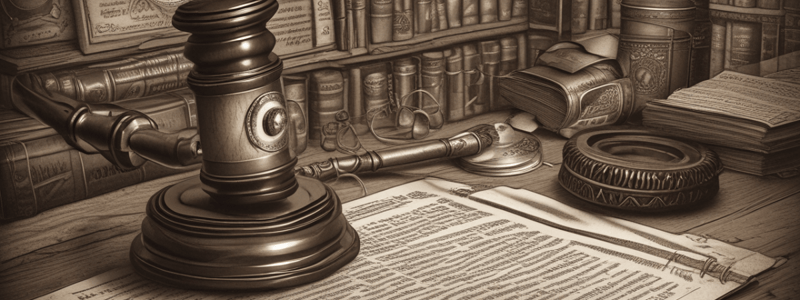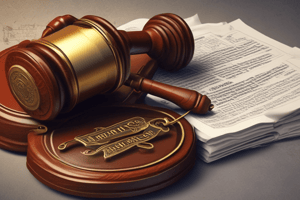Podcast
Questions and Answers
When should you create a crime scene sketch?
When should you create a crime scene sketch?
- Before photographing the scene
- After photographing the scene and before detailed work (correct)
- After writing the report
- After interviewing witnesses and suspects
What is the purpose of a crime scene sketch?
What is the purpose of a crime scene sketch?
- To supplement field notes and photographs (correct)
- To replace field notes and photographs
- To document only the testimony of witnesses
- To document only the positions of objects
What information should be written on a piece of paper or whiteboard before photographing or sketching a crime scene or person?
What information should be written on a piece of paper or whiteboard before photographing or sketching a crime scene or person?
- Case number, location, date and time, and officer's name (correct)
- Officer's name and report number only
- Case number and location only
- Date and time only
Why is it necessary to indicate in your report that you photographed or sketched the crime scene or person?
Why is it necessary to indicate in your report that you photographed or sketched the crime scene or person?
What can crime scene sketches show that are not easily visible in photographs?
What can crime scene sketches show that are not easily visible in photographs?
When can you use crime scene sketches during an interview?
When can you use crime scene sketches during an interview?
What should you do with the sketches if you use them during an interview?
What should you do with the sketches if you use them during an interview?
Why is it important to document where you recovered evidence in the scene?
Why is it important to document where you recovered evidence in the scene?
What is the primary purpose of an investigation at a crime scene?
What is the primary purpose of an investigation at a crime scene?
What is the significance of the good-faith exception doctrine?
What is the significance of the good-faith exception doctrine?
What is the primary goal when securing a crime scene?
What is the primary goal when securing a crime scene?
What type of communication is protected by privilege?
What type of communication is protected by privilege?
What is the focus of the preliminary investigation?
What is the focus of the preliminary investigation?
What is the significance of ensuring that crime scene evidence is admissible?
What is the significance of ensuring that crime scene evidence is admissible?
What is the role of privileged communications in an investigation?
What is the role of privileged communications in an investigation?
What is the primary goal of a crime scene investigation?
What is the primary goal of a crime scene investigation?
What should be the primary consideration when searching for evidence at a crime scene?
What should be the primary consideration when searching for evidence at a crime scene?
What is the benefit of using a grid search pattern indoors?
What is the benefit of using a grid search pattern indoors?
Why is it important to study the whole scene before searching for evidence?
Why is it important to study the whole scene before searching for evidence?
What should you keep in mind when handling evidence?
What should you keep in mind when handling evidence?
What type of evidence would you search for at a burglary scene?
What type of evidence would you search for at a burglary scene?
When searching for evidence, what should you use to ensure a thorough search?
When searching for evidence, what should you use to ensure a thorough search?
What is the primary consideration when documenting photographs or sketches of a crime scene and evidence on a person?
What is the primary consideration when documenting photographs or sketches of a crime scene and evidence on a person?
Why is it important to use personal protective equipment (PPE) when searching and handling evidence?
Why is it important to use personal protective equipment (PPE) when searching and handling evidence?
What should you do when encountering a large amount of powder suspected to be fentanyl?
What should you do when encountering a large amount of powder suspected to be fentanyl?
What should you wear when handling substances suspected to be fentanyl or carfentanil?
What should you wear when handling substances suspected to be fentanyl or carfentanil?
What is the antidote for opioid overdose?
What is the antidote for opioid overdose?
What should you do when packaging sharp objects, such as needles or syringes?
What should you do when packaging sharp objects, such as needles or syringes?
What is a sign of exposure to fentanyl or carfentanil?
What is a sign of exposure to fentanyl or carfentanil?
What should you do when collecting drug paraphernalia?
What should you do when collecting drug paraphernalia?
Why should you have another officer nearby when conducting a field test on a substance suspected to be fentanyl or carfentanil?
Why should you have another officer nearby when conducting a field test on a substance suspected to be fentanyl or carfentanil?
Where should you place a substance suspected to be fentanyl or carfentanil when transporting it?
Where should you place a substance suspected to be fentanyl or carfentanil when transporting it?
What is the purpose of applying the lifting tape smoothly from the tabbed end to the rolled end?
What is the purpose of applying the lifting tape smoothly from the tabbed end to the rolled end?
Why is it essential to follow agency policies and procedures when handling firearms evidence?
Why is it essential to follow agency policies and procedures when handling firearms evidence?
What information should be recorded on the back of the fingerprint print card?
What information should be recorded on the back of the fingerprint print card?
What is the primary purpose of elimination prints in a crime scene investigation?
What is the primary purpose of elimination prints in a crime scene investigation?
Why should you avoid touching the lifting tape to another surface when lifting it from the print?
Why should you avoid touching the lifting tape to another surface when lifting it from the print?
What should you use to smooth out the lifting tape and release any trapped air?
What should you use to smooth out the lifting tape and release any trapped air?
What is the correct way to place the lifting tape on the fingerprint card?
What is the correct way to place the lifting tape on the fingerprint card?
What is the final step in collecting latent prints?
What is the final step in collecting latent prints?
Flashcards are hidden until you start studying
Study Notes
Crime Scene Investigation
- The good-faith exception doctrine allows evidence to be admissible in court even if the search warrant is later deemed invalid, as long as the officer executing the warrant believed it to be valid at the time.
Privileged Communication
- The Florida Evidence Code recognizes the importance of protecting certain privileged communications, such as those between a sexual assault counselor and victim, or a domestic violence advocate and victim.
- These communications are private, protected, and confidential, and their disclosure cannot be forced.
Securing and Protecting the Crime Scene
- The purpose of an investigation is to determine what happened, identify and locate the suspect, and develop enough evidence to establish probable cause to make an arrest.
- The preliminary investigation focuses on establishing whether a criminal act has been committed and, if so, what type and when and where it was committed.
Photographing Evidence
- Photograph evidence on a person before sketching the crime scene.
- Include the following information on a piece of paper or whiteboard and take a photograph:
- Case number
- Location
- Date and time
- Officer's name
- Indicate in the report that the photographs or sketches are true and accurate representations of the crime scene or person.
Sketching the Crime Scene
- Sketch the crime scene after photographing the scene and before beginning detailed work.
- A crime scene sketch supplements field notes and photographs, and aids in reconstruction, explanation, and permanent recording of an incident.
- Use sketches to document where evidence was recovered in the scene.
- Sketches can show positions of objects in relation to one another that are not easily visible in photographs.
Evidence-Handling Procedures
- Search for evidence using a systematic approach or pattern, depending on the type of crime committed.
- Use standard precautions and apply PPE when searching and handling evidence to avoid exposure to harmful substances.
- Follow agency policies and procedures for collecting, packaging, and preserving evidence.
Collecting Latent Prints
- Use a lifting tape to collect latent prints from a surface.
- Apply the tape carefully to avoid trapping foreign matter or air bubbles.
- Smooth out the tape from the tabbed end back toward the rolled end or vice versa.
- Lift the tape slowly, being careful not to touch the tape to another surface.
- Place the tape on the fingerprint card in the same way that it was placed over the print.
- Record the date, case number, location, and any other required information on the back of the fingerprint print card.
Elimination Prints
- Elimination prints allow fingerprint analysts to distinguish between prints belonging to victims and witnesses, or possible suspects.
- Take fingerprints from anyone who may have been at the crime scene to eliminate their prints from the pool of suspects.
Firearms Evidence
- When recovering a firearm or ammunition at a crime scene, follow agency policies and procedures for handling such evidence.
- Apply PPE to avoid contaminating the firearm or ammunition with fingerprints and DNA.
Chemical or Toxicological Evidence
- Identify various controlled substances and drug paraphernalia by sight or odor.
- Use a field test kit to test a substance before collecting and packaging it as evidence.
- Package sharp objects, such as needles or syringes, in puncture-proof packages clearly labeled with the words "WARNING: SHARPS."
- Follow agency policies and procedures for handling hazardous substances, such as fentanyl or carfentanil.
Fentanyl and Carfentanil
- Fentanyl and carfentanil are highly potent and hazardous substances that can be absorbed through mucous membranes.
- When encountering these substances, follow agency policies and procedures for field-testing, collecting, packaging, and transporting.
- Use PPE, such as gloves, long sleeves, a surgical or dust mask, and eye protection.
- Conduct field-testing in an open environment with no wind.
- Mark the package as "suspected fentanyl" and transport it with caution.
- If exposed to fentanyl or carfentanil, follow agency policies and procedures for decontamination.
- Signs of exposure include disorientation, difficulty speaking or walking, slowed pulse, nausea, slow shallow breathing, and respiratory arrest.
Studying That Suits You
Use AI to generate personalized quizzes and flashcards to suit your learning preferences.




